
70 Results

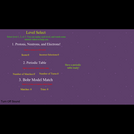
Reviews middle school chemistry for getting information about atomic structure and periodic table grouping.
- Subject:
- Chemistry
- Physical Science
- Material Type:
- Game
- Date Added:
- 10/12/2014
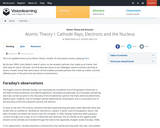
This lesson introduces J. J. Thomson's discovery of the electron and E. Rutherford's planetary model of atomic structure. This is the first in a series covering modern atomic theory.
- Subject:
- Astronomy
- Chemistry
- Education
- Physical Science
- Physics
- Space Science
- Material Type:
- Interactive
- Unit of Study
- Provider:
- UCAR Staff
- Provider Set:
- Visionlearning
- Author:
- Anthony Carpi
- Date Added:
- 03/17/2003
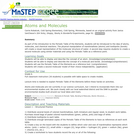
Both of these lessons are classroom activities that require students to build models that display understanding of atoms and molecules. One lesson is structured while the other is guided.
- Subject:
- Chemistry
- Physical Science
- Material Type:
- Activity/Lab
- Provider:
- Science Education Resource Center (SERC) at Carleton College
- Provider Set:
- Pedagogy in Action
- Author:
- Carrie Robatcek
- Date Added:
- 08/10/2012
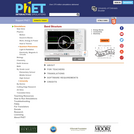
Explore the origin of energy bands in crystals of atoms. The structure of these bands determines how materials conduct electricity.
- Subject:
- Physical Science
- Physics
- Material Type:
- Simulation
- Provider:
- University of Colorado Boulder
- Provider Set:
- PhET Interactive Simulations
- Author:
- Carl Wieman
- Chris Malley
- Kathy Perkins
- Sam McKagan
- Date Added:
- 10/04/2006
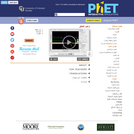
Explore the origin of energy bands in crystals of atoms. The structure of these bands determines how materials conduct electricity.
- Subject:
- Physical Science
- Physics
- Material Type:
- Simulation
- Provider:
- University of Colorado Boulder
- Provider Set:
- PhET Interactive Simulations
- Author:
- Carl Wieman
- Chris Malley
- Kathy Perkins
- Sam McKagan
- Date Added:
- 07/02/2010
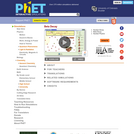
Watch beta decay occur for a collection of nuclei or for an individual nucleus.
- Subject:
- Physical Science
- Material Type:
- Simulation
- Provider:
- University of Colorado Boulder
- Provider Set:
- PhET Interactive Simulations
- Author:
- Carl Wieman
- John Blanco
- Kathy Perkins
- Noah Podolefsky
- Wendy Adams
- Date Added:
- 09/01/2009
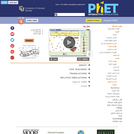
Watch beta decay occur for a collection of nuclei or for an individual nucleus.
- Subject:
- Physical Science
- Material Type:
- Simulation
- Provider:
- University of Colorado Boulder
- Provider Set:
- PhET Interactive Simulations
- Author:
- Carl Wieman
- John Blanco
- Kathy Perkins
- Noah Podolefsky
- Wendy Adams
- Date Added:
- 02/02/2013
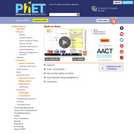
Build an atom out of protons, neutrons, and electrons, and see how the element, charge, and mass change. Then play a game to test your ideas!
- Subject:
- Chemistry
- Physical Science
- Material Type:
- Simulation
- Provider:
- University of Colorado Boulder
- Provider Set:
- PhET Interactive Simulations
- Author:
- Jack Barbera
- John Blanco
- Kathy Perkins
- Kelly Lancaster
- Patricia Loeblein
- Robert Parson
- Sam Reid
- Suzanne Brahmia
- Date Added:
- 07/13/2011

This activity is a hands-on building of atoms of elements 1-20.
- Subject:
- Chemistry
- Physical Science
- Material Type:
- Activity/Lab
- Provider:
- Science Education Resource Center (SERC) at Carleton College
- Provider Set:
- Pedagogy in Action
- Author:
- Peggy Knetter-Johnson
- Date Added:
- 08/16/2012
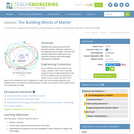
Students learn about atoms and their structure (protons, electrons, neutrons) — the building blocks of matter. They see how scientific discoveries about atoms and molecules influence new technologies developed by engineers.
- Subject:
- Chemistry
- Physical Science
- Material Type:
- Lesson
- Provider:
- TeachEngineering
- Provider Set:
- TeachEngineering
- Author:
- Brian Kay
- Daria Kotys-Schwartz
- Janet Yowell
- Malinda Schaefer Zarske
- Date Added:
- 02/17/2017

CK-12 Physical Science Concepts covers the study of physical science for middle school students. The 5 chapters provide an introduction to physical science, matter, states of matter, chemical interactions and bonds, chemical reactions, motion and forces, and the types and characteristics of energy.
- Subject:
- Chemistry
- Physical Science
- Material Type:
- Textbook
- Provider:
- CK-12 Foundation
- Provider Set:
- CK-12 FlexBook
- Author:
- Jean Brainard, Ph.D.
- Date Added:
- 11/01/2012
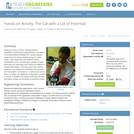
Working in teams of three, students perform quantitative observational experiments on the motion of LEGO MINDSTORMS(TM) NXT robotic vehicles powered by the stored potential energy of rubber bands. They experiment with different vehicle modifications (such as wheel type, payload, rubber band type and lubrication) and monitor the effects on vehicle performance. The main point of the activity, however, is for students to understand that through the manipulation of mechanics, a rubber band can be used in a rather non-traditional configuration to power a vehicle. In addition, this activity reinforces the idea that elastic energy can be stored as potential energy.
- Subject:
- Applied Science
- Chemistry
- Engineering
- Physical Science
- Material Type:
- Activity/Lab
- Provider:
- TeachEngineering
- Provider Set:
- TeachEngineering
- Author:
- Brian Kay
- Daria Kotys-Schwartz
- Janet Yowell
- Malinda Schaefer Zarske
- Date Added:
- 09/18/2014
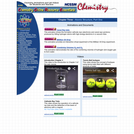
This collection of videos, animations and documents comes from the NCSSM AP chemistry online course. Chapter three part one provides practice and demonstrations related to atomic structure in chemistry.
- Subject:
- Chemistry
- Physical Science
- Material Type:
- Activity/Lab
- Simulation
- Provider:
- North Carolina School of Science and Mathematics
- Provider Set:
- Chemistry Online Resource Essentials
- Date Added:
- 01/01/2002
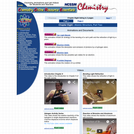
This collection of videos, animations and documents comes from the NCSSM AP chemistry online course. Chapter eight provides practice and demonstrations in chemistry related to Atomic Structure, (this is part two).
- Subject:
- Chemistry
- Physical Science
- Material Type:
- Activity/Lab
- Simulation
- Provider:
- North Carolina School of Science and Mathematics
- Provider Set:
- Chemistry Online Resource Essentials
- Date Added:
- 01/01/2002
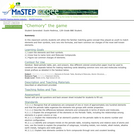
Matching game, including matching common ionic charges and ions and the compounds they form and naming of greek prefixes for covalent molecules.
- Subject:
- Chemistry
- Physical Science
- Material Type:
- Activity/Lab
- Provider:
- Science Education Resource Center (SERC) at Carleton College
- Provider Set:
- Pedagogy in Action
- Author:
- Dustin Redinius
- Date Added:
- 08/10/2012
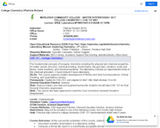
The fundamental concepts of inorganic chemistry including the physical and chemical properties of matter, atomic structure, chemical bonding, stoichiometry, the gas laws, solutions, acids and bases, redox reactions, and chemical equilibria. The laboratory includes an experimental study of the chemical principles. 3 hours lecture/3 hours laboratory.
- Subject:
- Chemistry
- Physical Science
- Material Type:
- Full Course
- Provider:
- Middlesex Community College
- Author:
- Patricia Richard
- Date Added:
- 05/13/2019

This is a laboratory exercise designed to allow students to further investigate the light spectrum. This lab is used to have students view the light spectrum first hand as opposed to using lecture alone.
- Subject:
- Applied Science
- Chemistry
- Engineering
- Physical Science
- Physics
- Material Type:
- Activity/Lab
- Assessment
- Lesson Plan
- Provider:
- Science Education Resource Center (SERC) at Carleton College
- Provider Set:
- Pedagogy in Action
- Author:
- Ramsey Miller
- Date Added:
- 12/13/2011

This interactive, scaffolded activity allows students to build an atom within the framework of a newer orbital model. It opens with an explanation of why the Bohr model is incorrect and provides an analogy for understanding orbitals that is simple enough for grades 8-9. As the activity progresses, students build atoms and ions by adding or removing protons, electrons, and neutrons. As changes are made, the model displays the atomic number, net charge, and isotope symbol. Try the "Add an Electron" page to build electrons around a boron nucleus and see how electrons align from lower-to-higher energy. This item is part of the Concord Consortium, a nonprofit research and development organization dedicated to transforming education through technology. The Concord Consortium develops deeply digital learning innovations for science, mathematics, and engineering. The models are all freely accessible. Users may register for additional free access to capture data and store student work products.
- Subject:
- Applied Science
- Chemistry
- Physical Science
- Physics
- Technology
- Material Type:
- Lesson
- Provider:
- Concord Consortium
- Provider Set:
- Concord Consortium Collection
- Author:
- The Concord Consortium
- Date Added:
- 05/06/2011
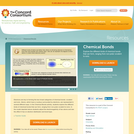
This interactive activity helps learners visualize the role of electrons in the formation of ionic and covalent chemical bonds. Students explore different types of chemical bonds by first viewing a single hydrogen atom in an electric field model. Next, students use sliders to change the electronegativity between two atoms -- a model to help them understand why some atoms are attracted. Finally, students experiment in making their own models: non-polar covalent, polar covalent, and ionic bonds. This item is part of the Concord Consortium, a nonprofit research and development organization dedicated to transforming education through technology.
- Subject:
- Applied Science
- Chemistry
- Physical Science
- Physics
- Technology
- Material Type:
- Lesson
- Provider:
- Concord Consortium
- Provider Set:
- Concord Consortium Collection
- Author:
- National Science Foundation
- The Concord Consortium
- Date Added:
- 05/16/2011